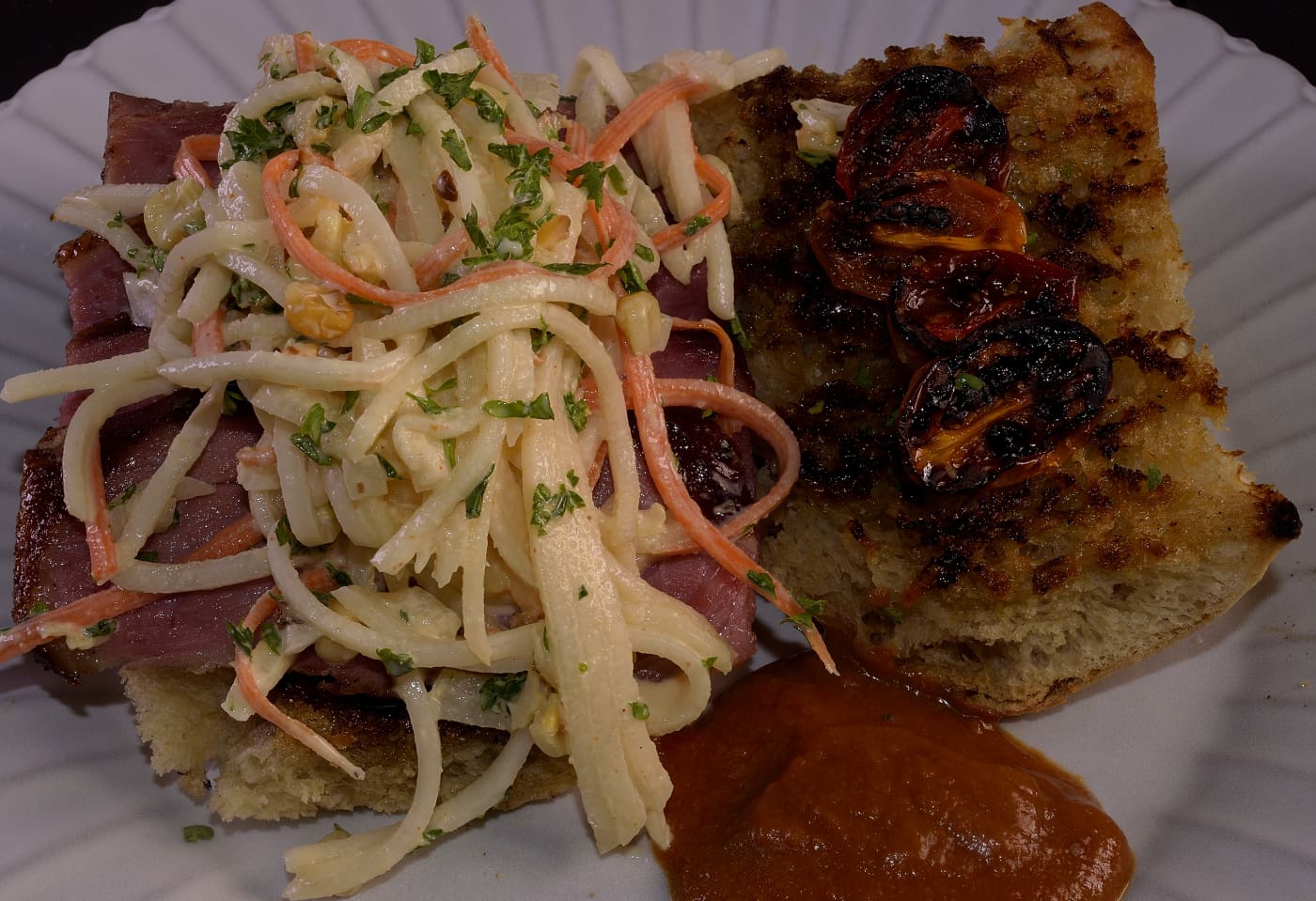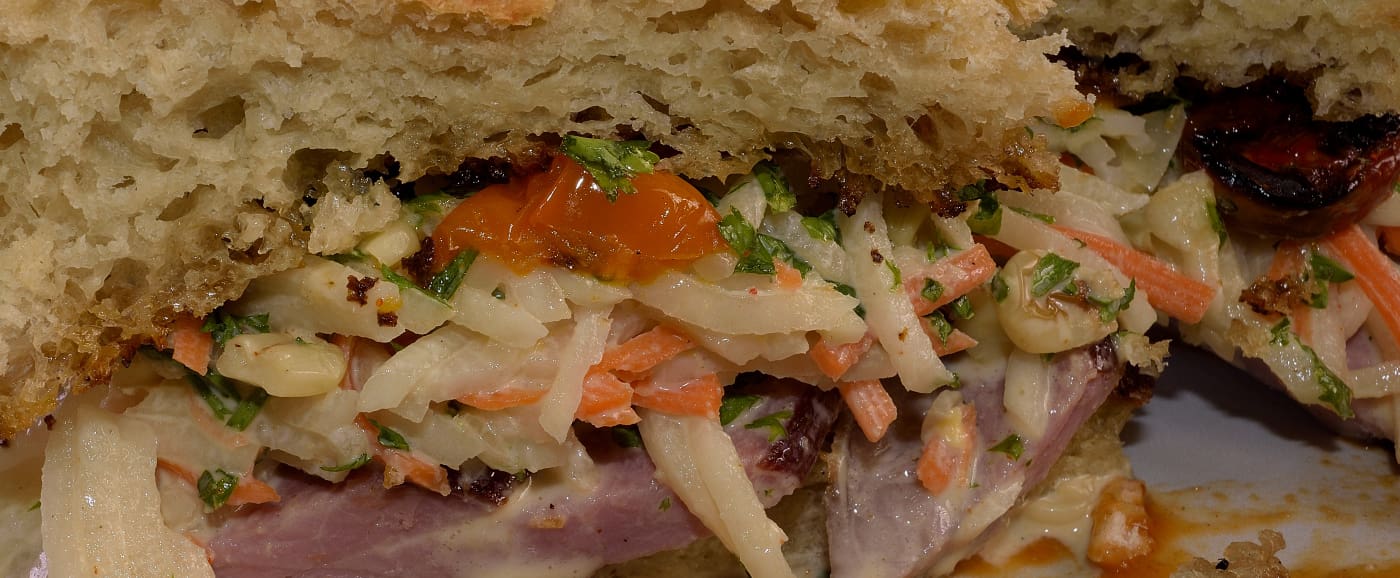Serves 4-20+
Level of difficulty 2.75
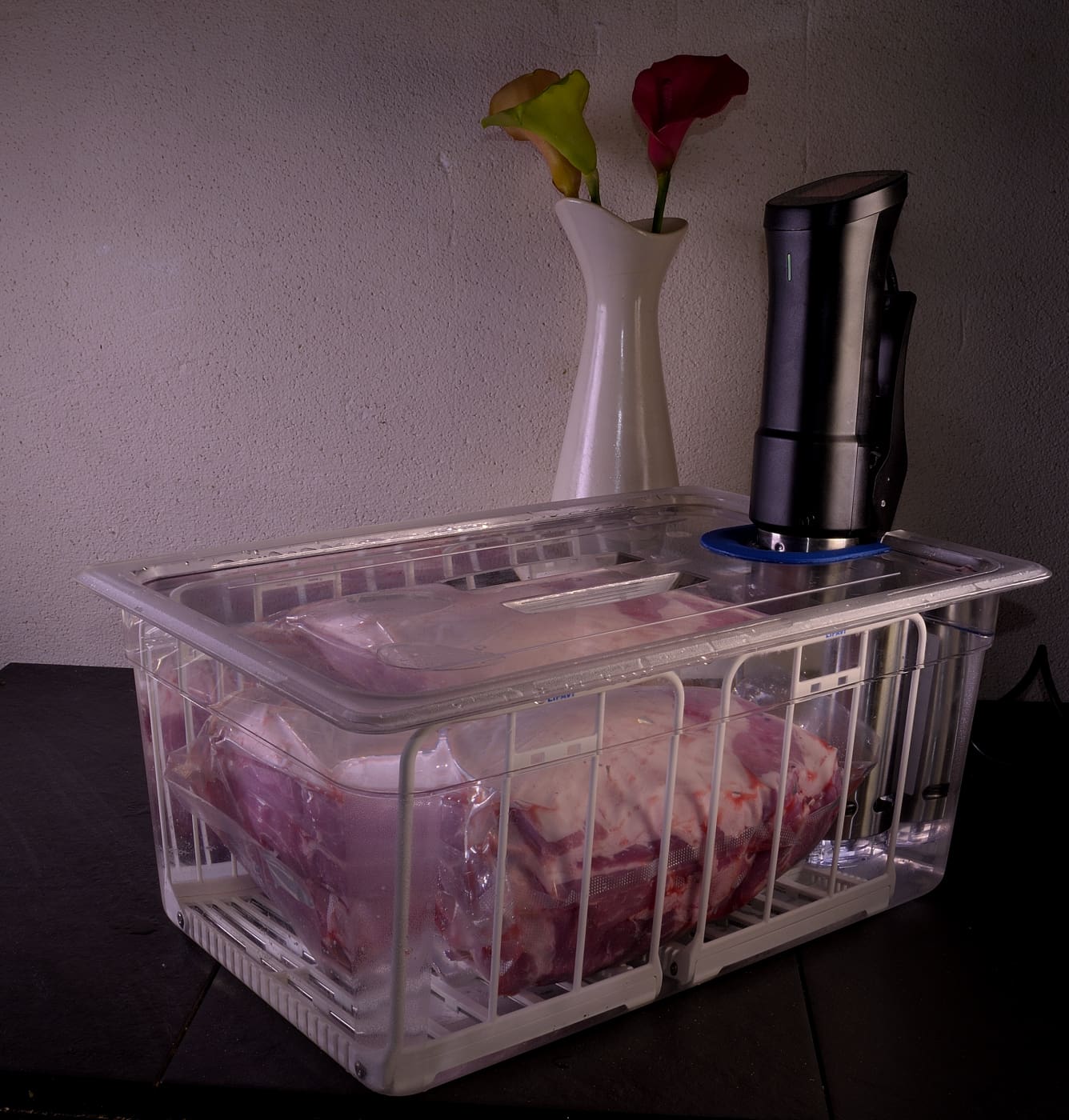
Above: Lipavi C15 container, N15 polycarbonate racks. Lipavi C15L-UNIR lid, Inkbird immersion circulator.
Processing the roast:
Preheat the sous vide bath to 183 F/84 C.
Note: This unusually high temperature accelerates the pork through the temperature danger zone (40F/4C-125F/52C). The sealed roast is staged into the bath and the temperature is immediately lowered to 135 F/57 C. Reducing the temperature prevents moisture loss, excessive shrinkage and overcooking. Note: If you want to proceed directly to pulled pork, visit HERE.
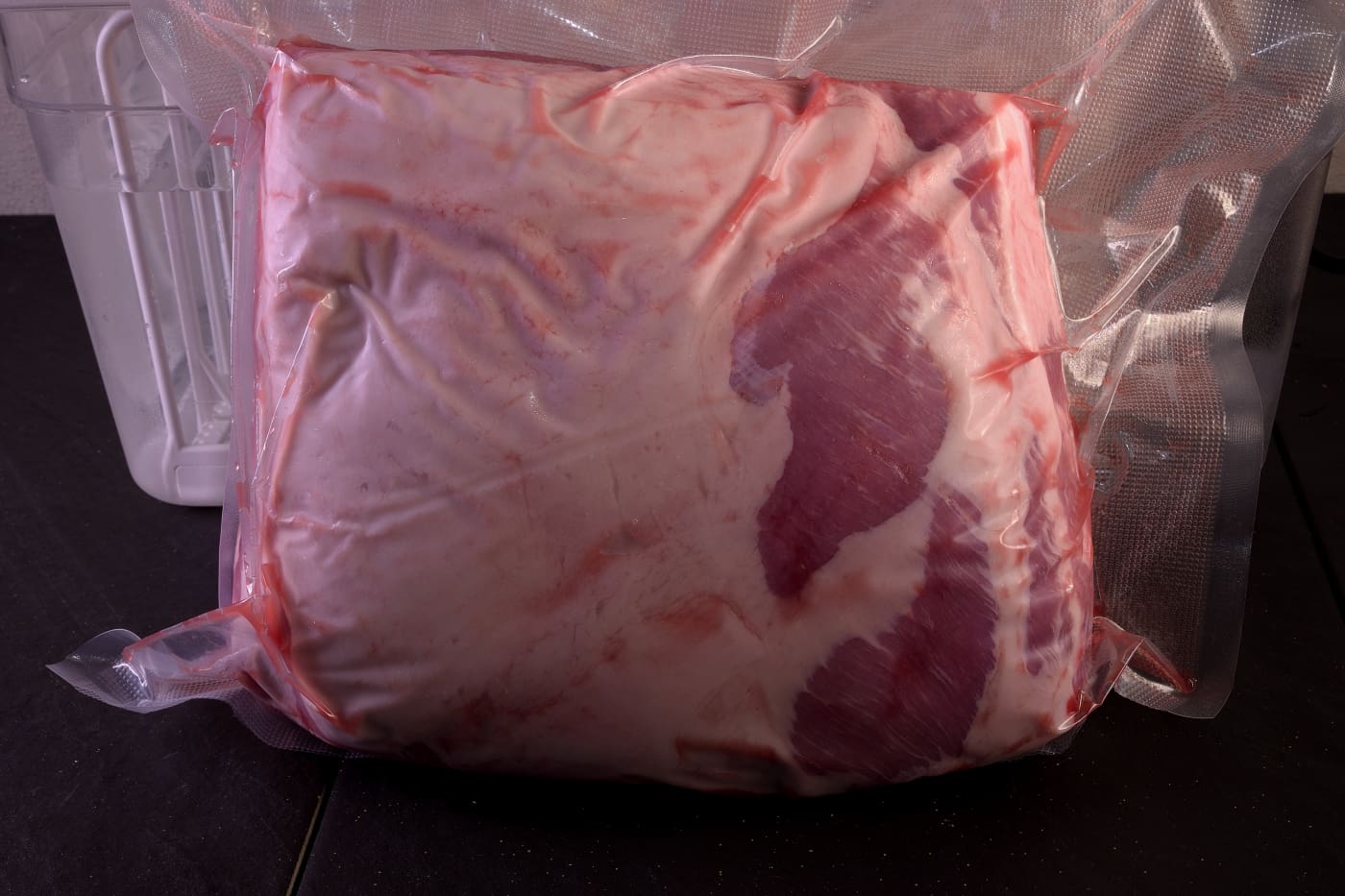
Vacuum seal the pork in heat rated vacuum bags. The time/tenderization interval is dictated by the shortest distance from the surface to the geometrical center, not the actual weight. A full sized roast may also be cut into smaller pieces without significantly altering the time/temperature parameters.
Go big?
Extra large sleeves are available on-line to accommodate large roasts. If the sleeve is wider than the sealing bar on a channel vacuum, each end of the bag is sealed twice at opposing angles–the empty sleeve is turned at 45 degrees to seal half of the opening on the heat bar. The bag is turned and the remaining “half” opening is sealed (see below).
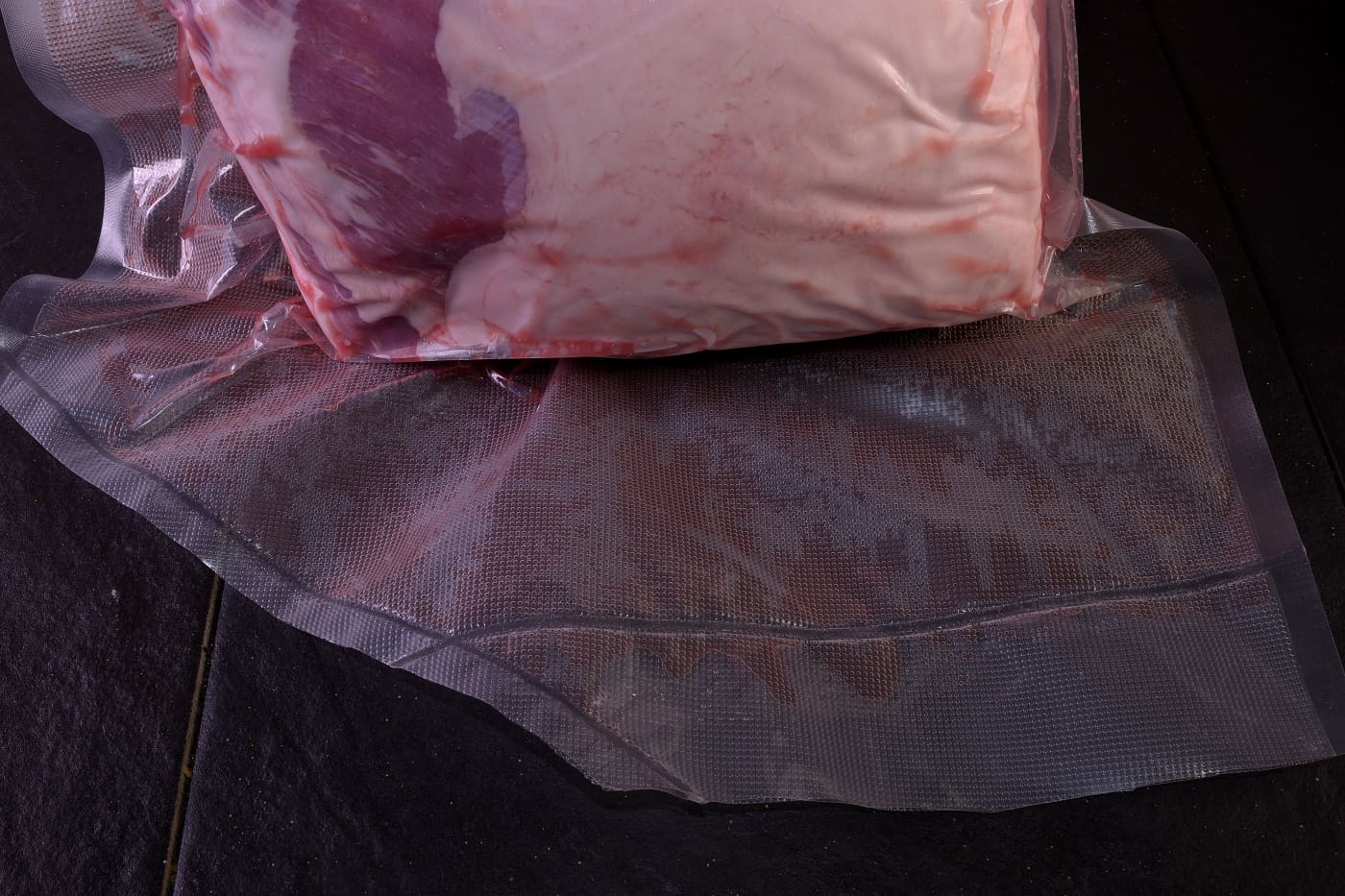
After loading the whole roast into the large sleeve, seal the other end of the bag at angles as shown above. Vacuum is only applied for the last step.
Stage the sealed roast into the sous vide bath. Remember to LOWER THE TEMPERATURE TO 135 F/57 C. Process the roast for a minimum of 24 hours. The longer you process the roast, the more tender it will become. Temperatures govern appearance of doneness and safety–they should always be applied with attention to precision.
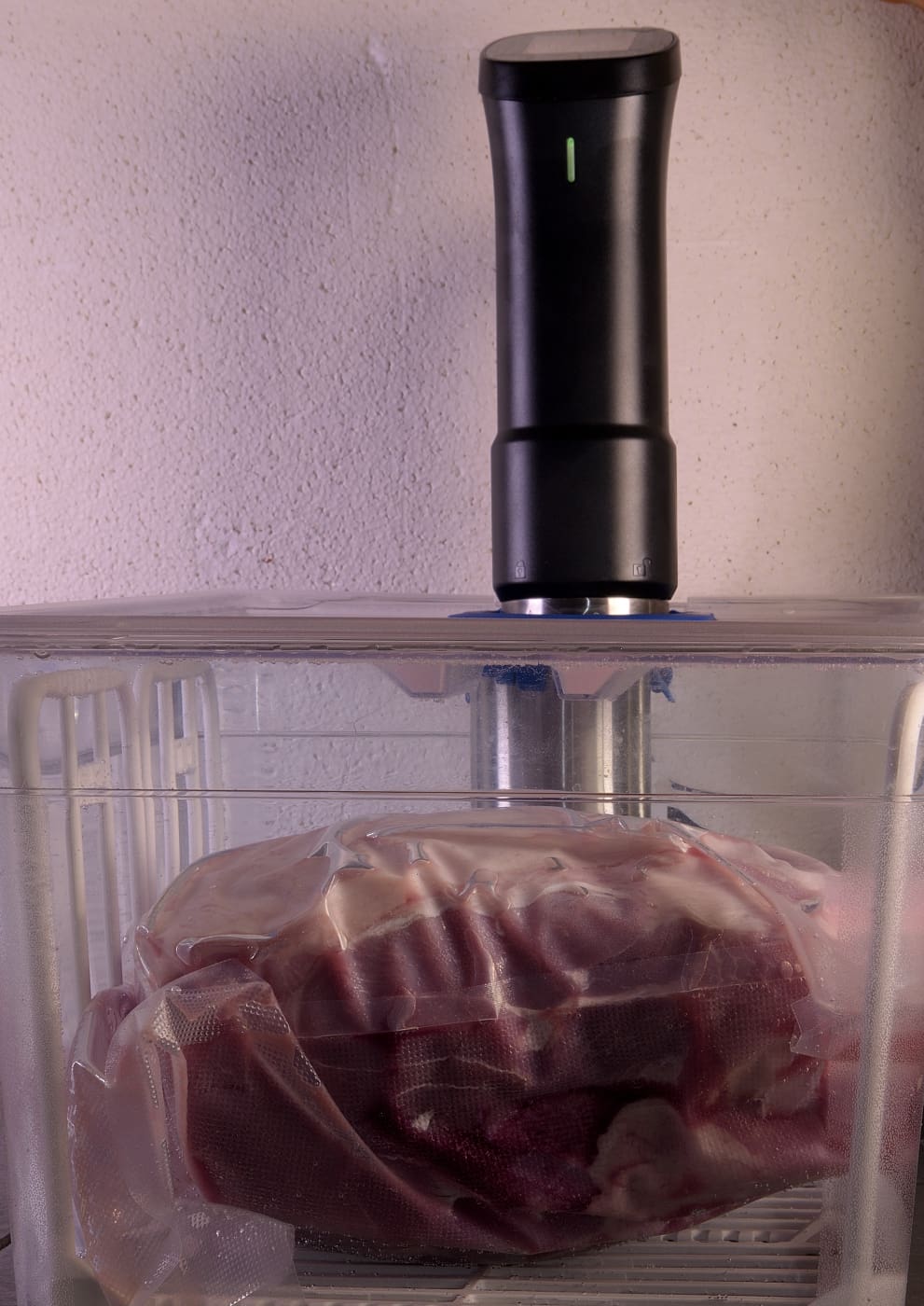
The roast must be fully submerged with room for water to circulate around all surfaces of the roast. The roast must not come in contact with the bottom or sides of the container. Lipavi containers and racks are specifically designed for this purpose.
When the processing time has elapsed, shock the package in iced water until it achieves 70 F/21 C. This very important safety procedure for roasts of this size applies whether you are processing sous vide or not. A roast (or a turkey) of this size should NEVER be cooled at room temperature–it takes too long to meet established safety guidelines. Since most of the smoke flavoring is imparted at temperatures below 140 F/60 C, failure to cold shock the roast before staging it into the smoker will limit the amount of smoke flavor transferred to the roast.
Be cool, Man
Submerge the packaged roast in a container of iced tap water that is at least twice the volume of the roast. Consider that meat is almost the same density as water. In this case, we use a vessel or sink that can hold at least 3 gallons/12 liters of cold water. How can you tell when the internal temperature of a large roast–or even a small one–has achieved 70 F/21 C?
Then what?
Submerge the roast in the filled vessel/sink. Wait until any ice has melted. The water’s temperature will be approximately 70 F/21 C. Wait 15 minutes and use a probe or infrared thermometer to measure the water’s temperature. If it is above 70 F/21 C, drain the vessel/sink, refill with cold tap water and wait 15 minutes. Repeat this process until the water steadies at 70 F/21 C. It will then be safe to refrigerate the roast at 40 F/4 C. In this state, the roast can be safely refrigerated for two weeks without compromising quality or wholesomeness.
Day of service
Seasoning your roast
Visit HERE to access some other customized rub and seasoning recipes that we have created. If preferred, you may use your favorite proprietary rub. Most retail rubs are composed of sodium compounds and sugar. Garlic powder is a common ingredient, with paprika for color. Manufacturers reconstitute these components into multi-colored pebbles to catch our attention. I will concede that they are very convenient, but I almost always make my own.
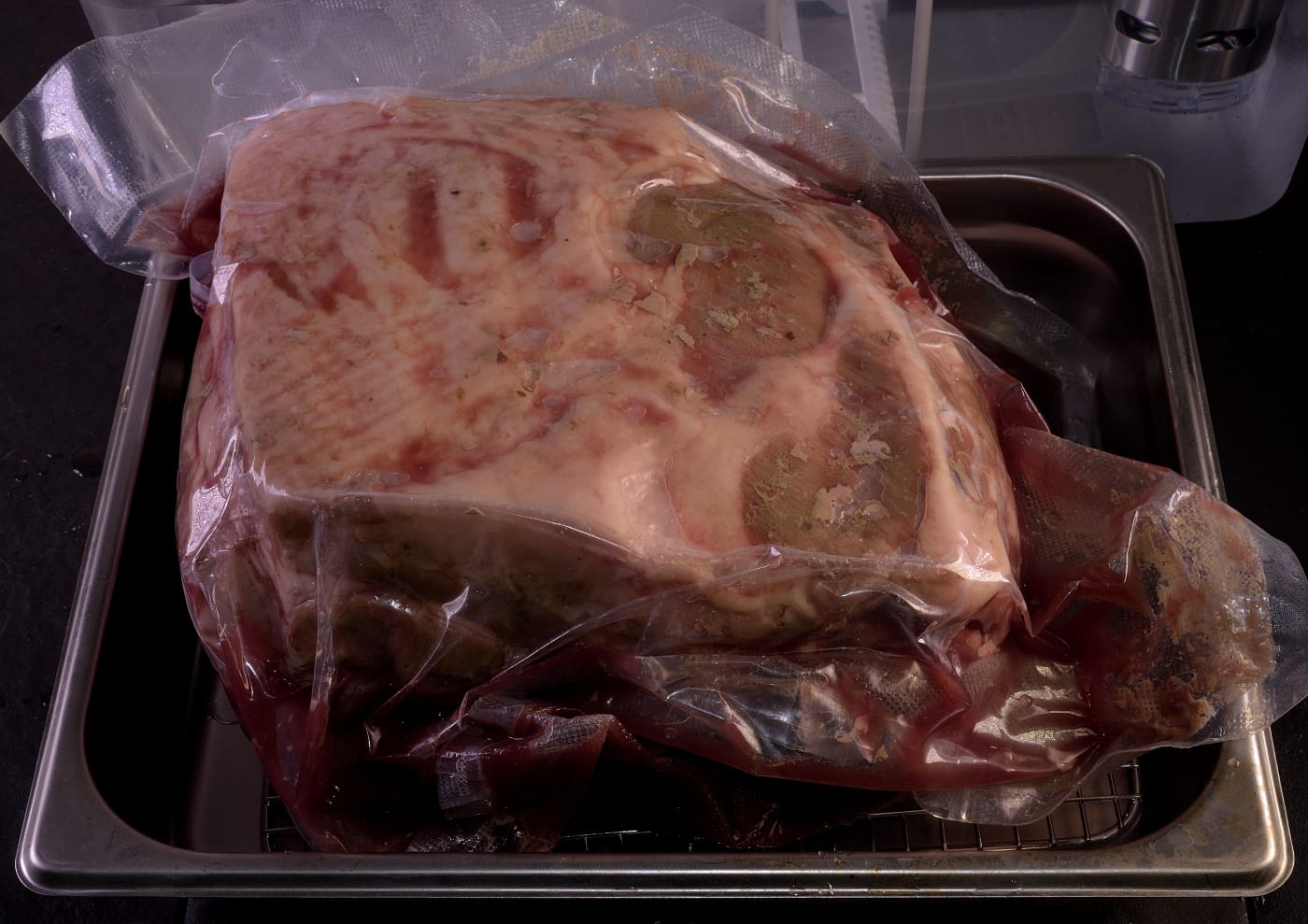
Submerge the entire cold package for 5-10 minutes in a preheated sous vide bath or hot tap water (110+ F/44+ C) to fully melt the gel. Cut one of the corners of the bag and collect the juices.

These gelatin rich juices are packed with flavor but cannot be used in this form. The myoglobin and albuminous proteins released during processing must be denatured and strained out.
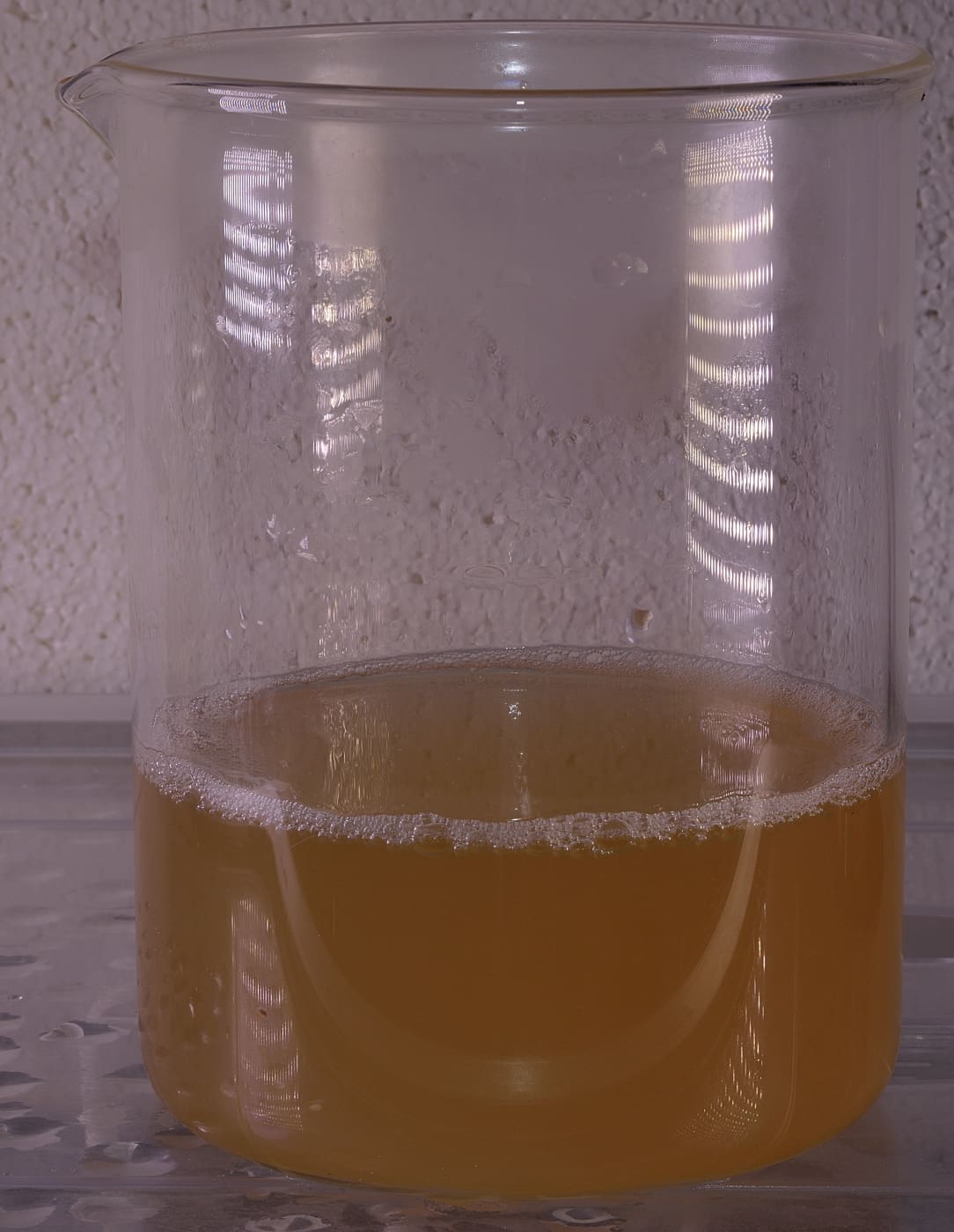
Click HERE to learn how to clarify the juices, which are well suited to moisten the pulled pork. They can also be used in almost any recipe that calls for stock or water.
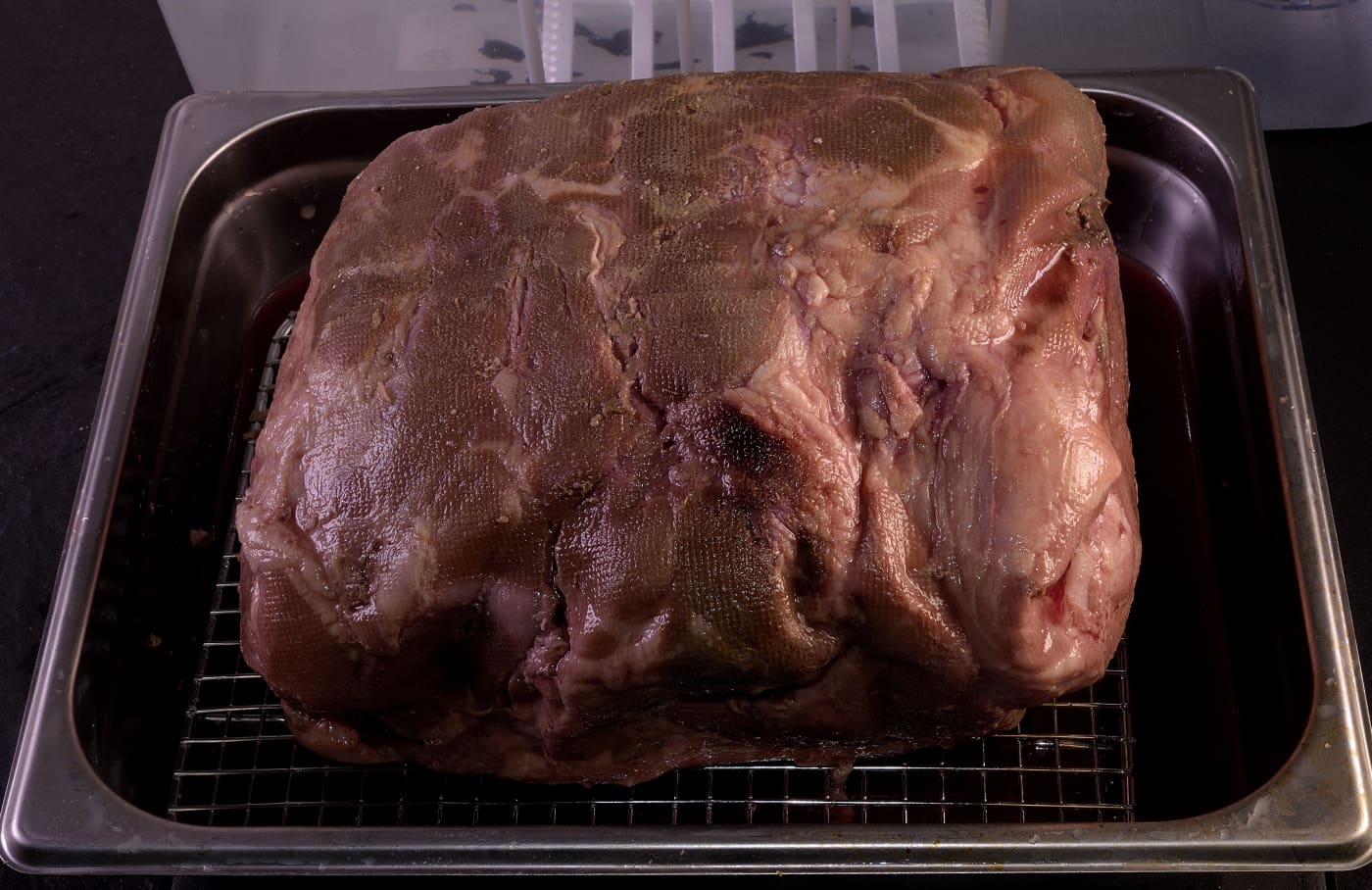
Remove the roast from bag and pat dry with paper towels. We will create a sticky surface so that our rub clings to the roast.
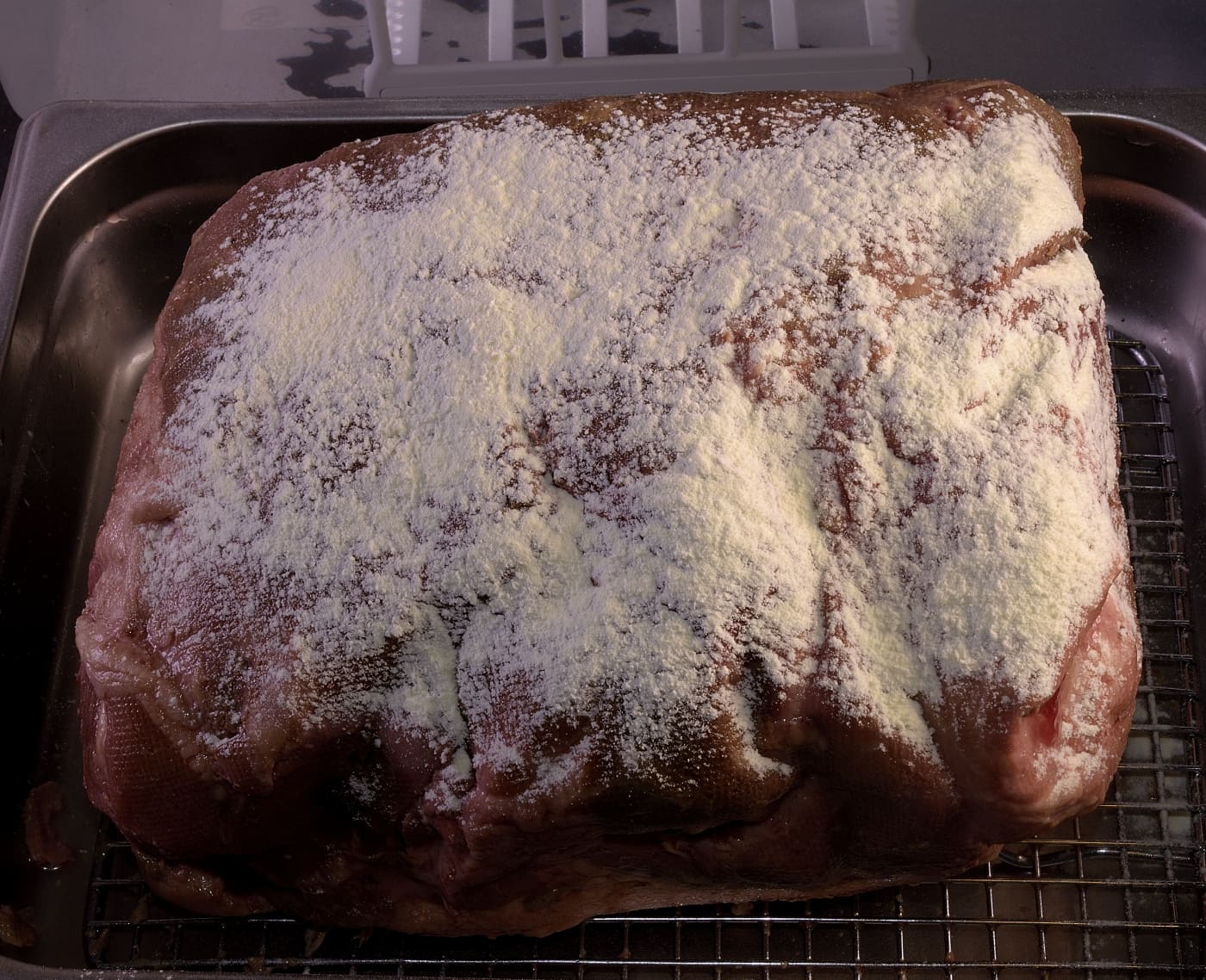
Use a dredge/shaker to sprinkle the surface with powdered egg whites. A fresh egg white beaten with an equal amount of water will achieve the same result.
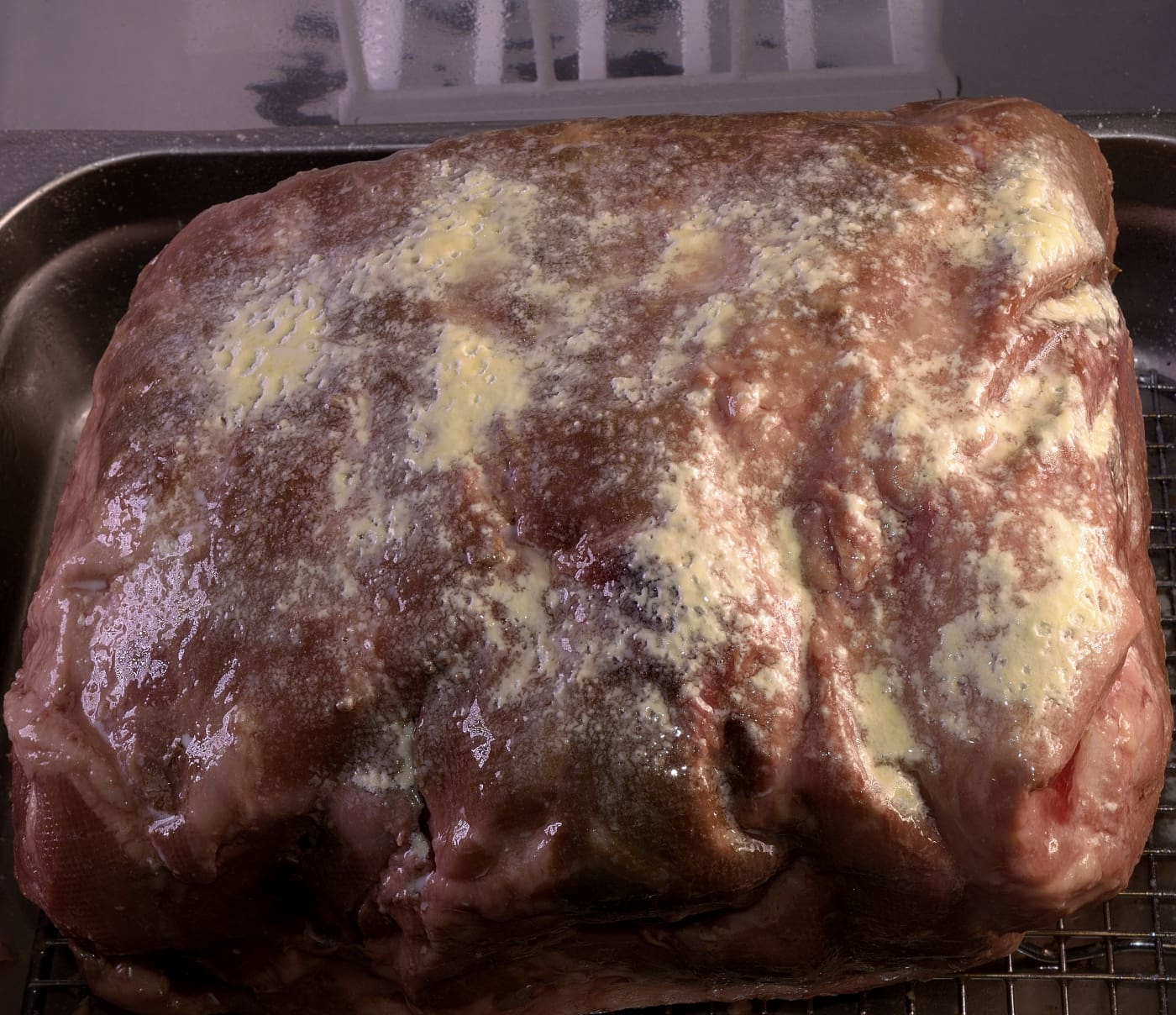
Use a spray bottle filled with water to dissolve the powdered egg white–skip this step if you are using fresh egg white. Use gloved hands to smear an even coating on the top and sides of the roast.
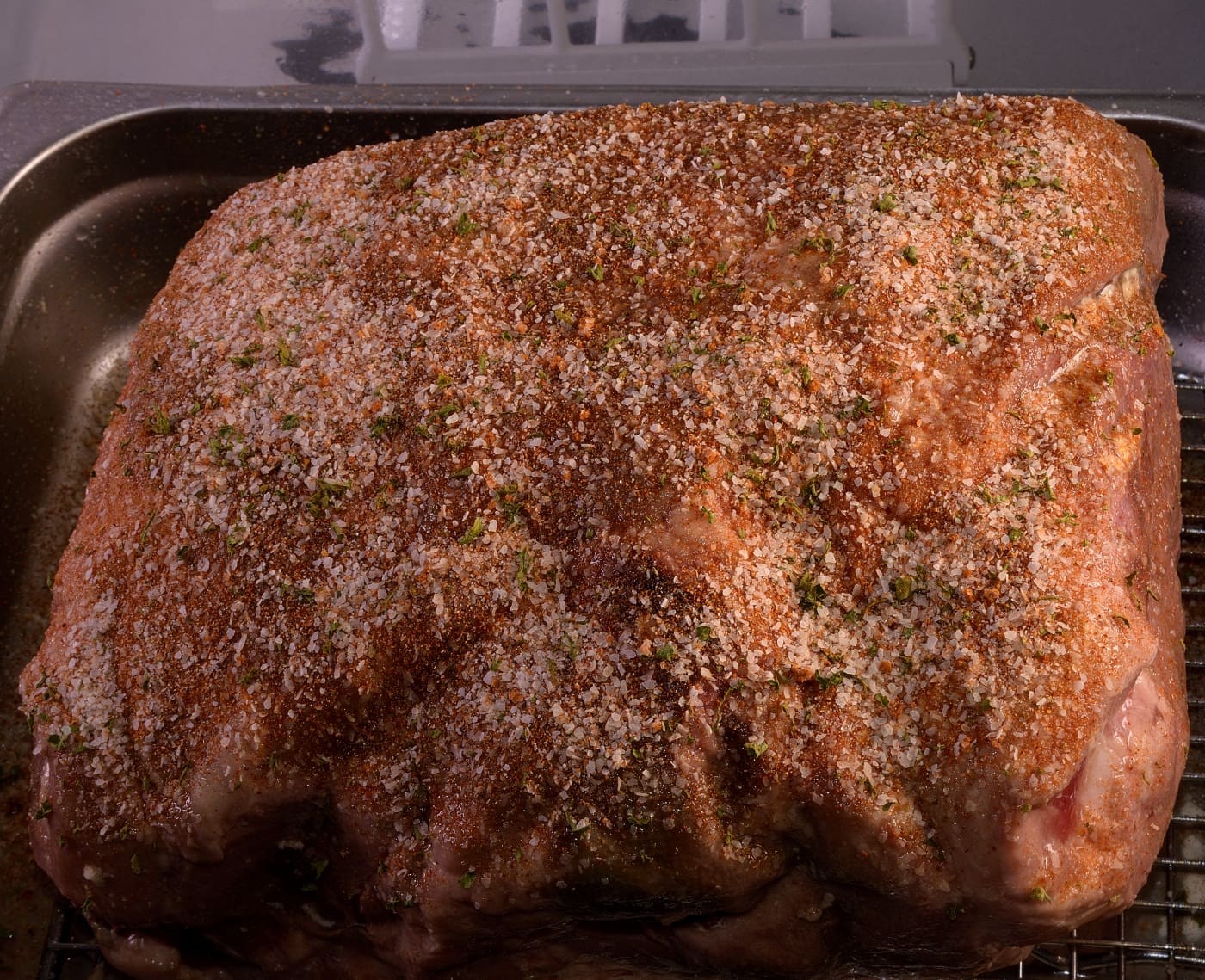
Sprinkle generously with your choice of seasonings.
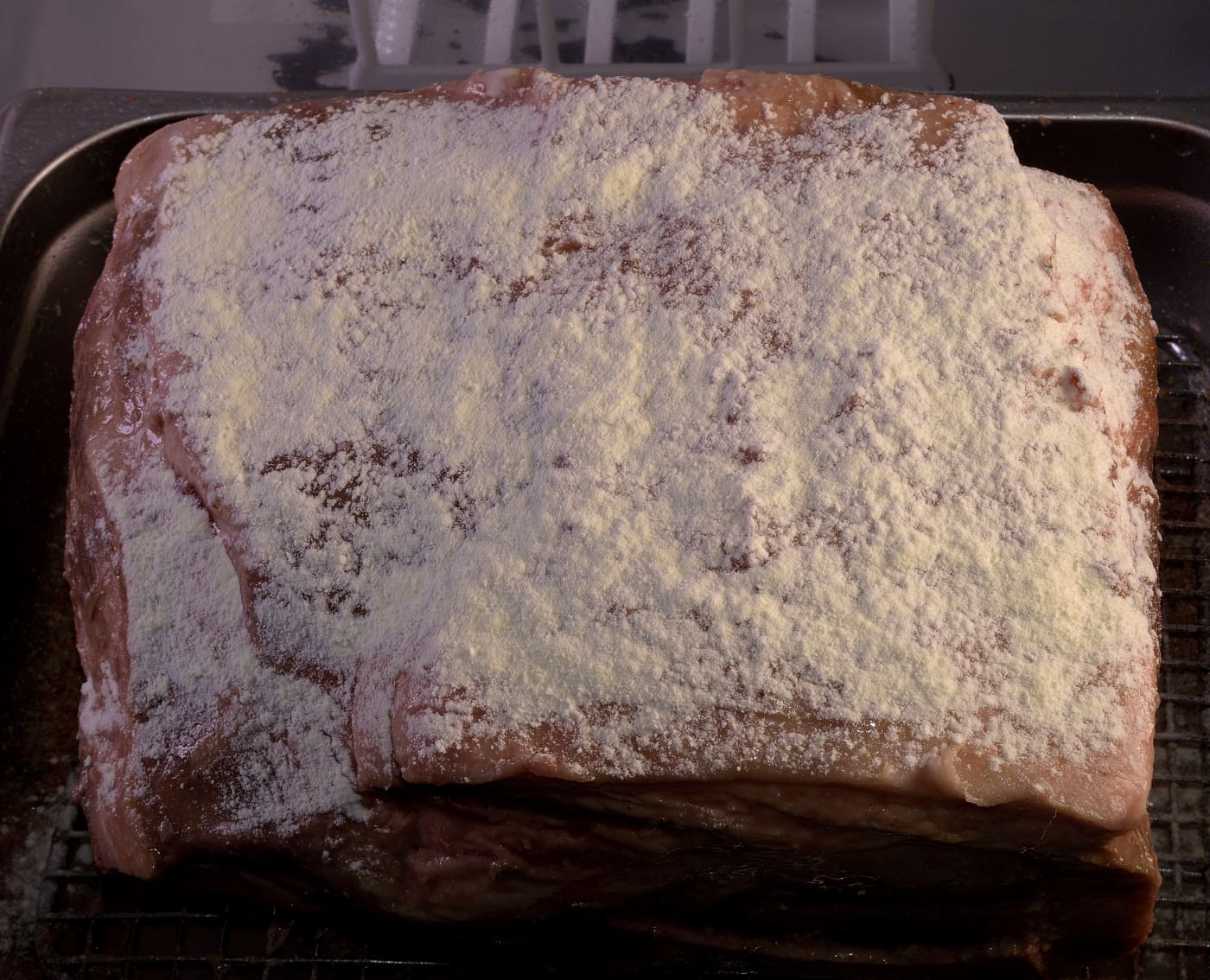
Turn the roast over and repeat the coating process.
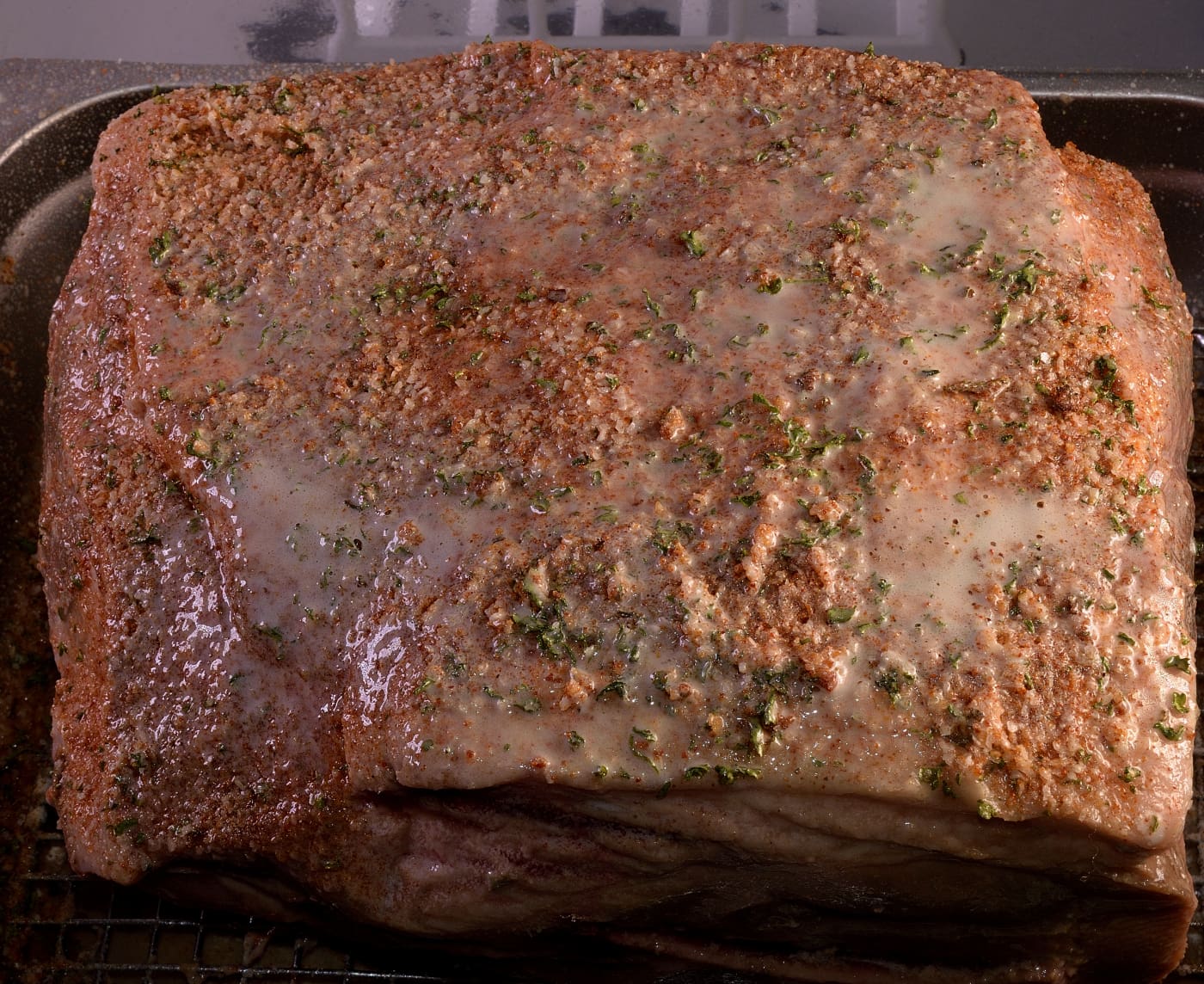
After seasoning the second side, mist with spray release or drizzle with oil.
Roast/Steak style:
Set the smoker on 200 F/93 C. Smoke the roast until an internal temperature of 140F/60C is achieved–approximately 6 hours.
Note: If you want to proceed directly to pulled pork, visit HERE.
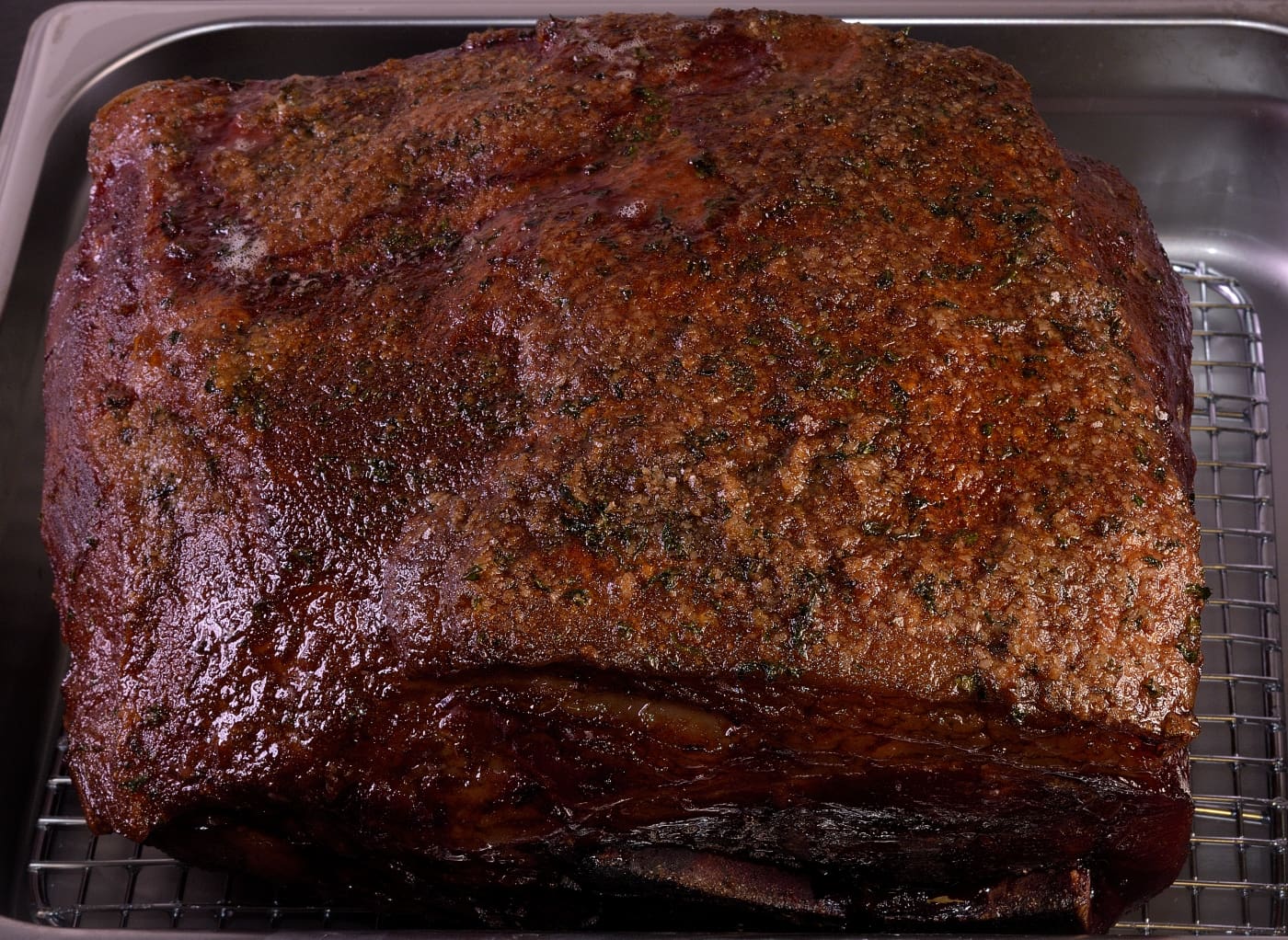
An internal temperature of 140 F/60 C will achieve roast/steak texture.
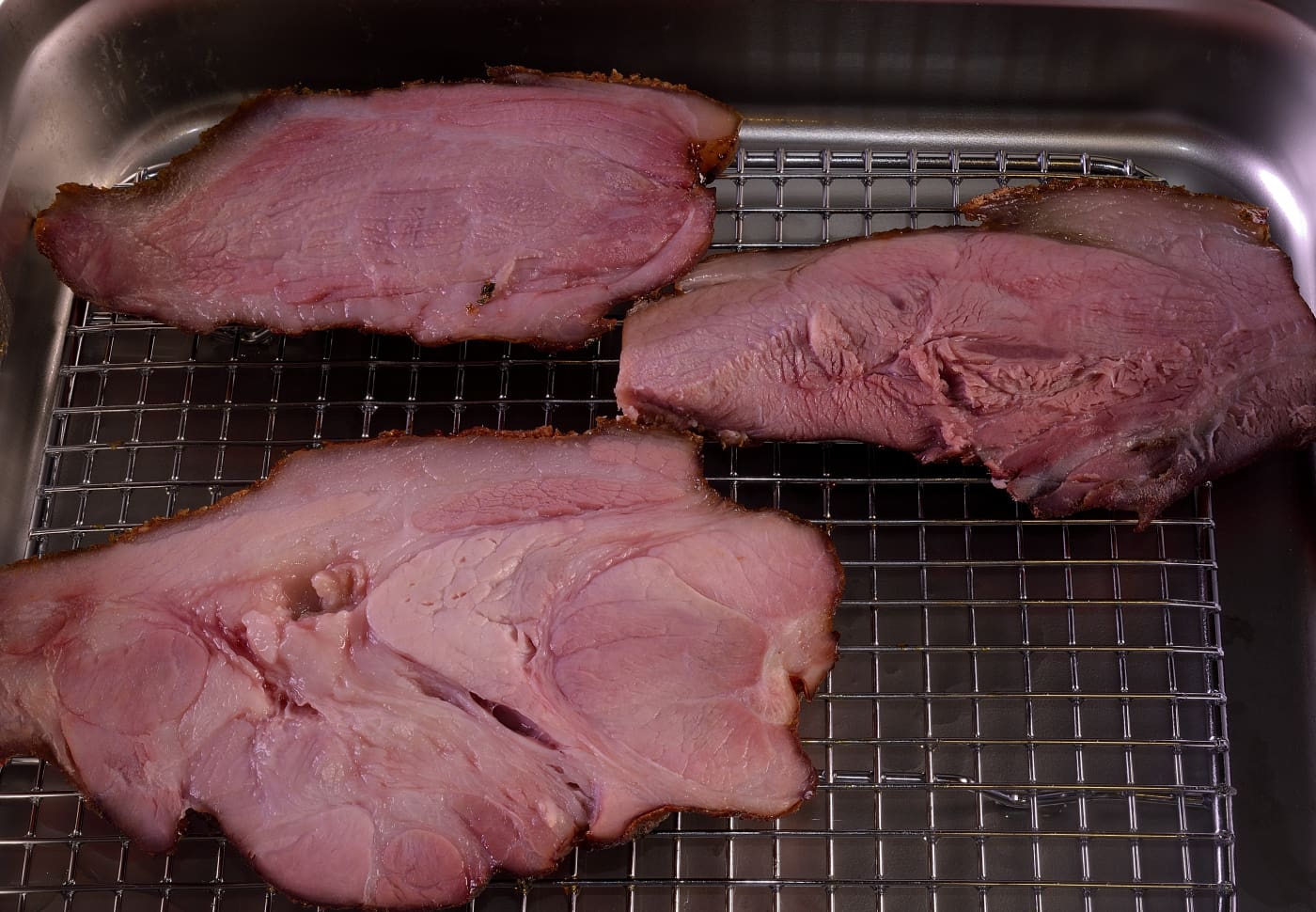
Even though the pork has been pasteurized, it may retain a rosy hue. This coloration is caused by the presence of myoglobin–not blood. Myoglobin is an oxygen transporting protein that occurs in muscle. Blood courses through veins. Diners’ preferences notwithstanding, color is not an indication of doneness or safety. Ham is red because of the color preserving chemical reaction between nitrites and myoglobin–we do not question it because we are all accustomed to it. If desired, a propane torch or a few seconds in the broiler/salamander function of your home oven will create a more familiar appearance.

The characteristic “smoke ring” should be visible. This phenomenon contributes no flavor and is not an indication of smoke penetration. The smoke ring is the result of meat’s exposure to unburned fuel in the cabinet–CO, carbon monoxide and NO, nitric oxide, which also preserves the color of myoglobin.
As a roast
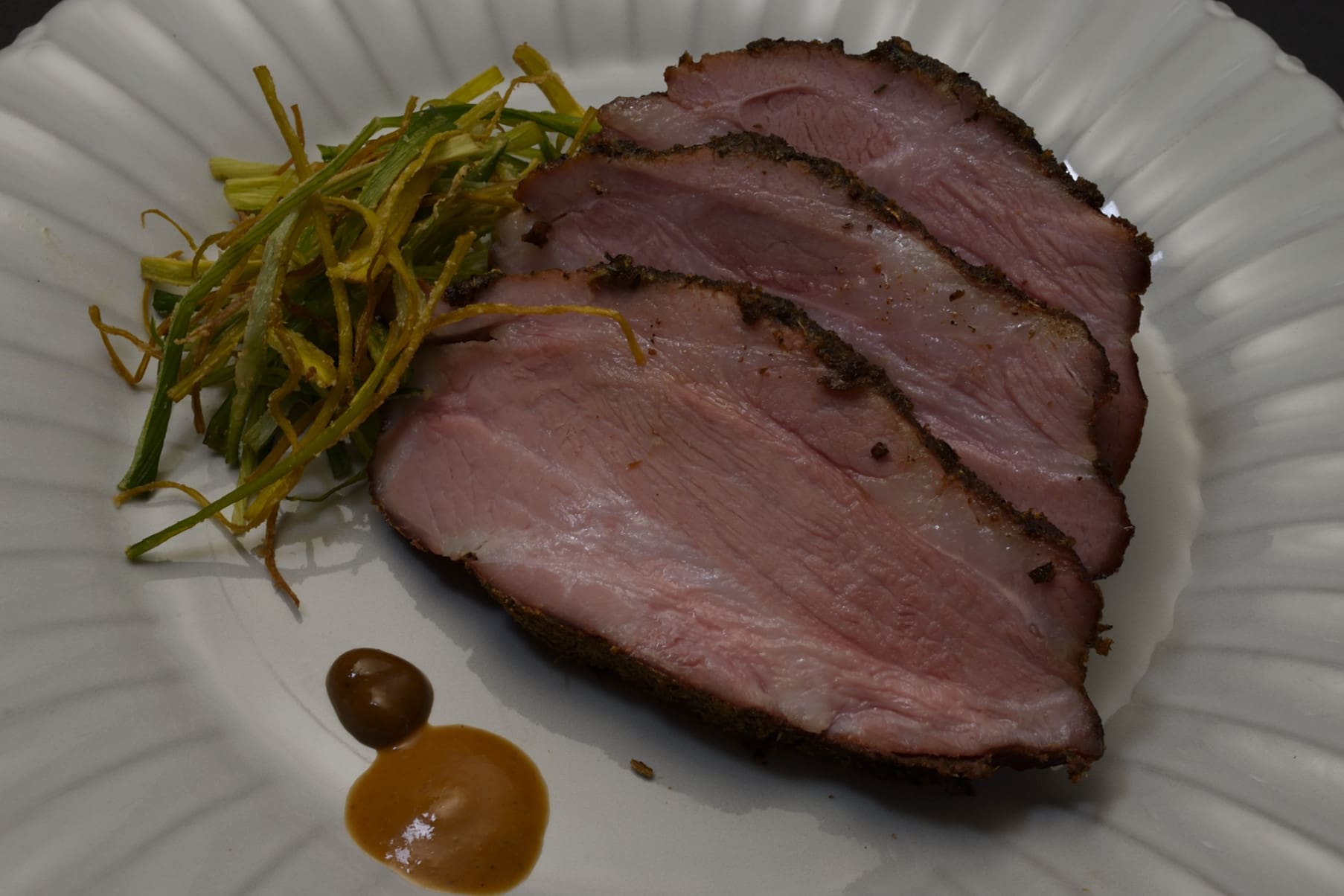
Above, served with some crispy leeks and Tamarind sauces.
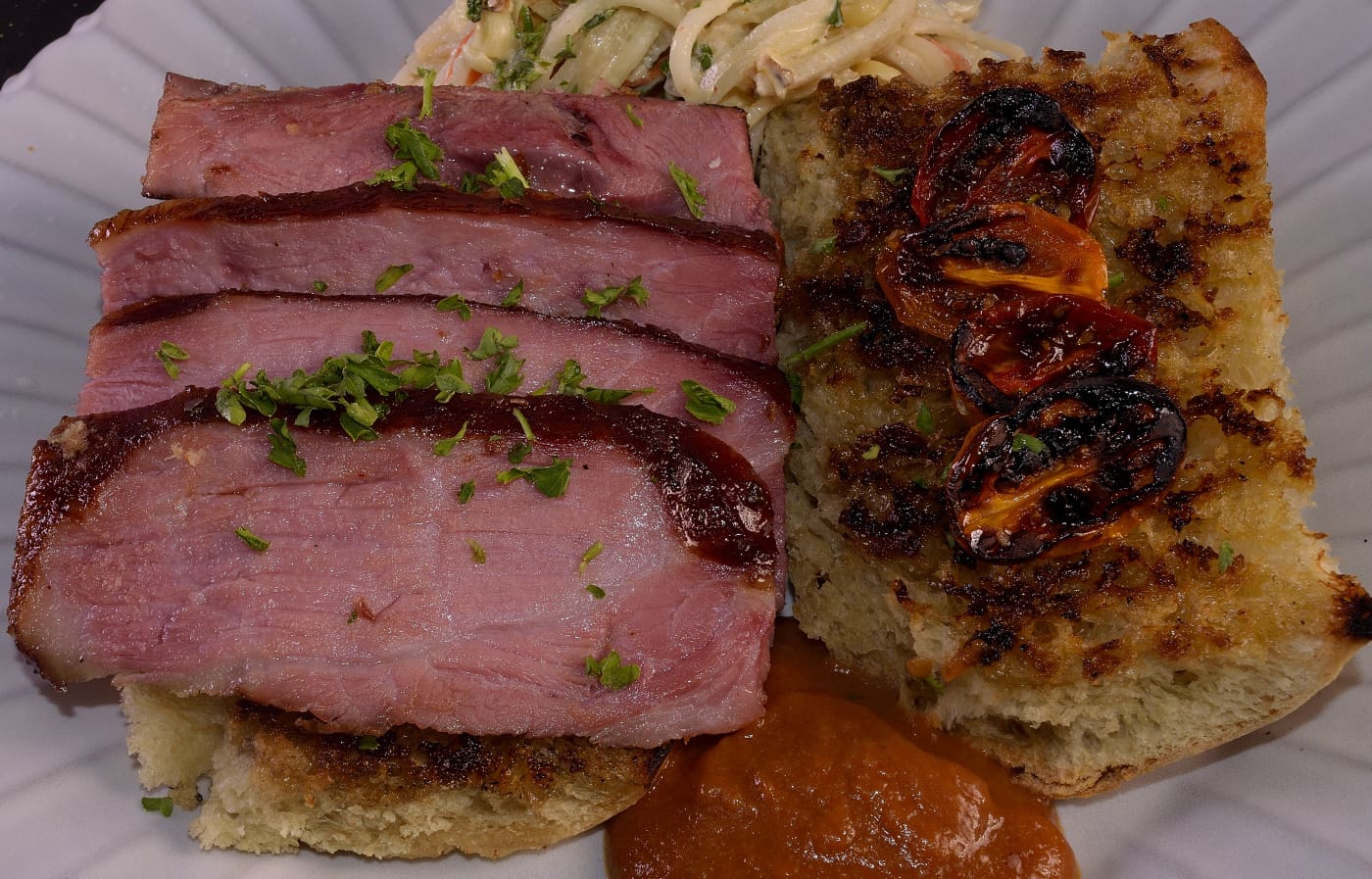
Great as a dipping sandwich, too! Oven broiled grape tomatoes. Brisk Barbecue Sauce,
A refreshing kohlrabi slaw with carrots and roasted corn. Kohlrabi is a cruciferous vegetable like broccoli, cabbage, cauliflower and of course kale. It has a mild taste like a peeled broccoli stem. Simply replace the cabbage in our soon to be famous coleslaw recipe with kohlrabi, peeled and sliced into strips or even shredded.
Makes for a colorful profile!
As a steak
Cut a slice of the roast (hot or cold) and season lightly with the powdered egg white procedure explained above.
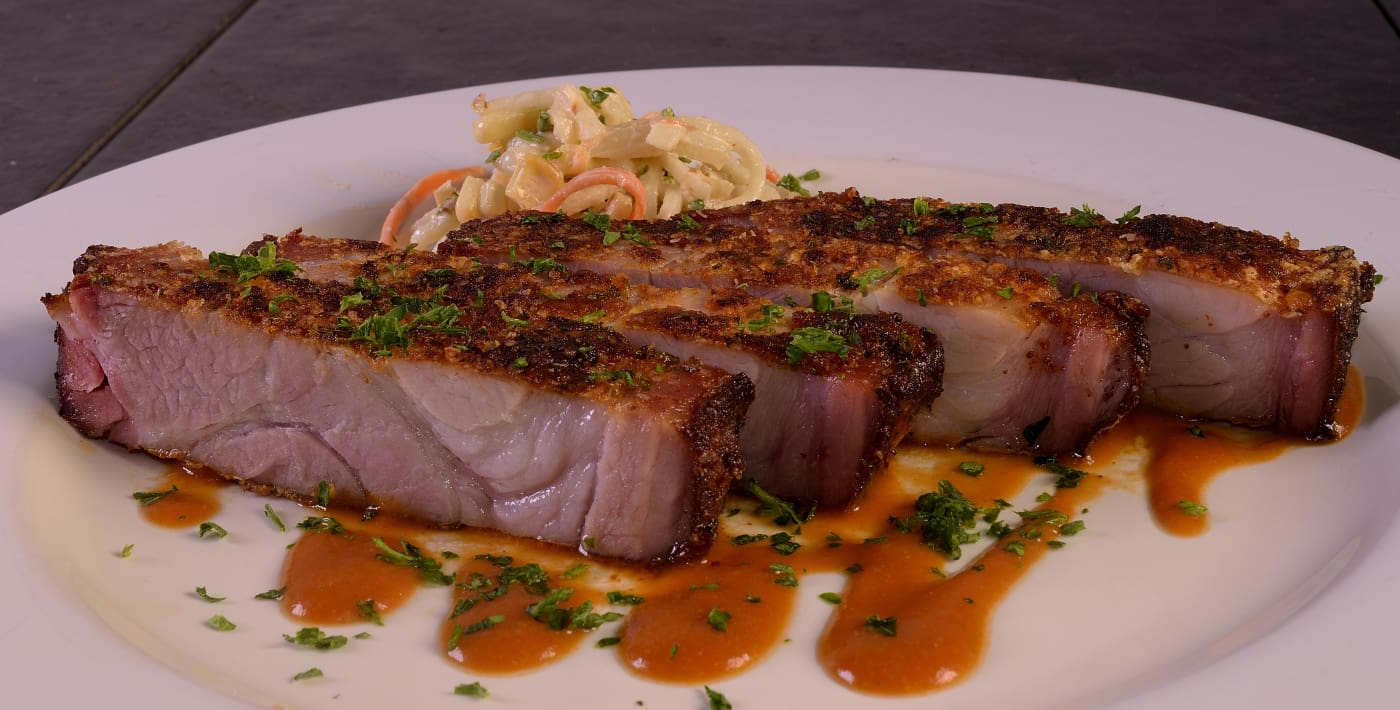
Sear in a well oiled skillet at 250 F/121 C.
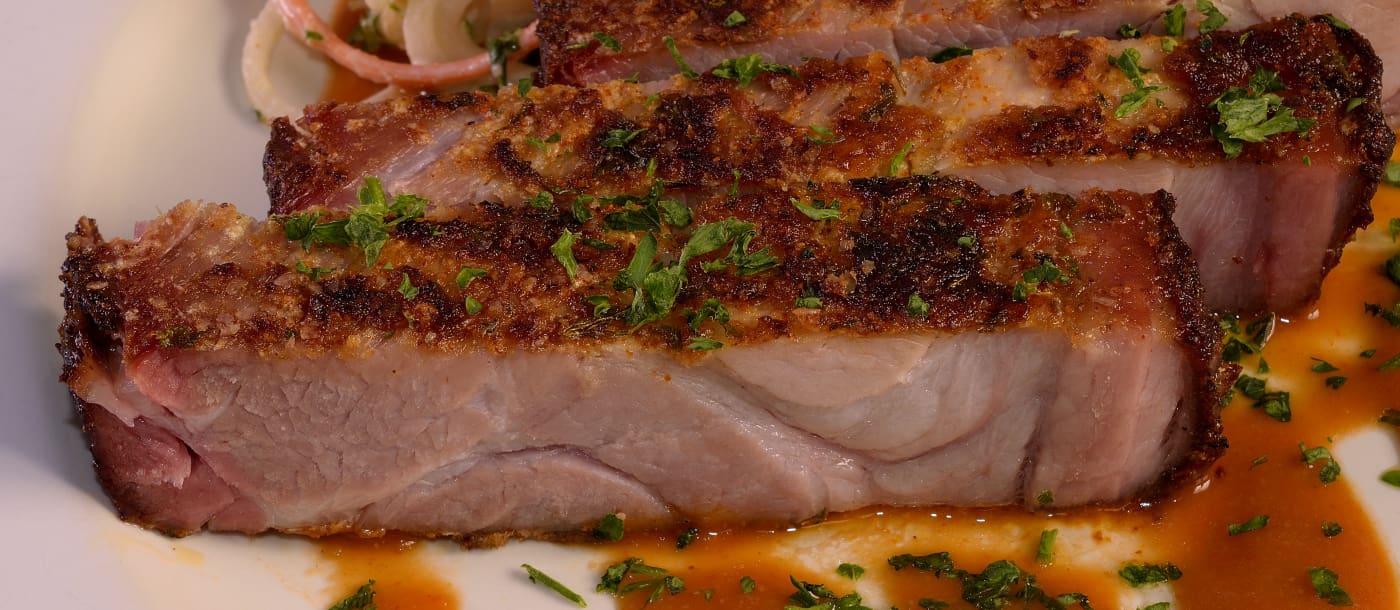
or…
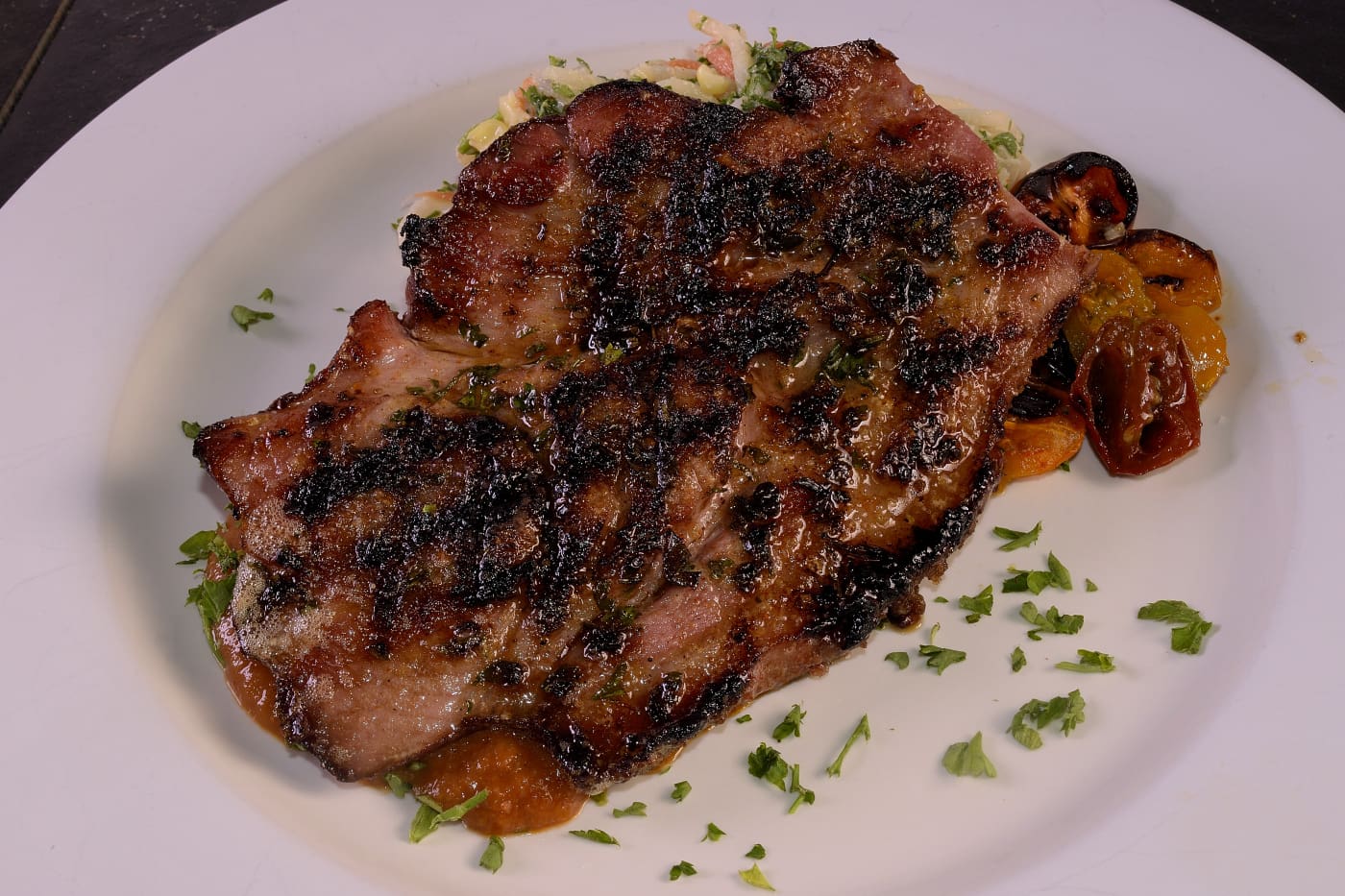
Grill in a cast iron pan with grates.
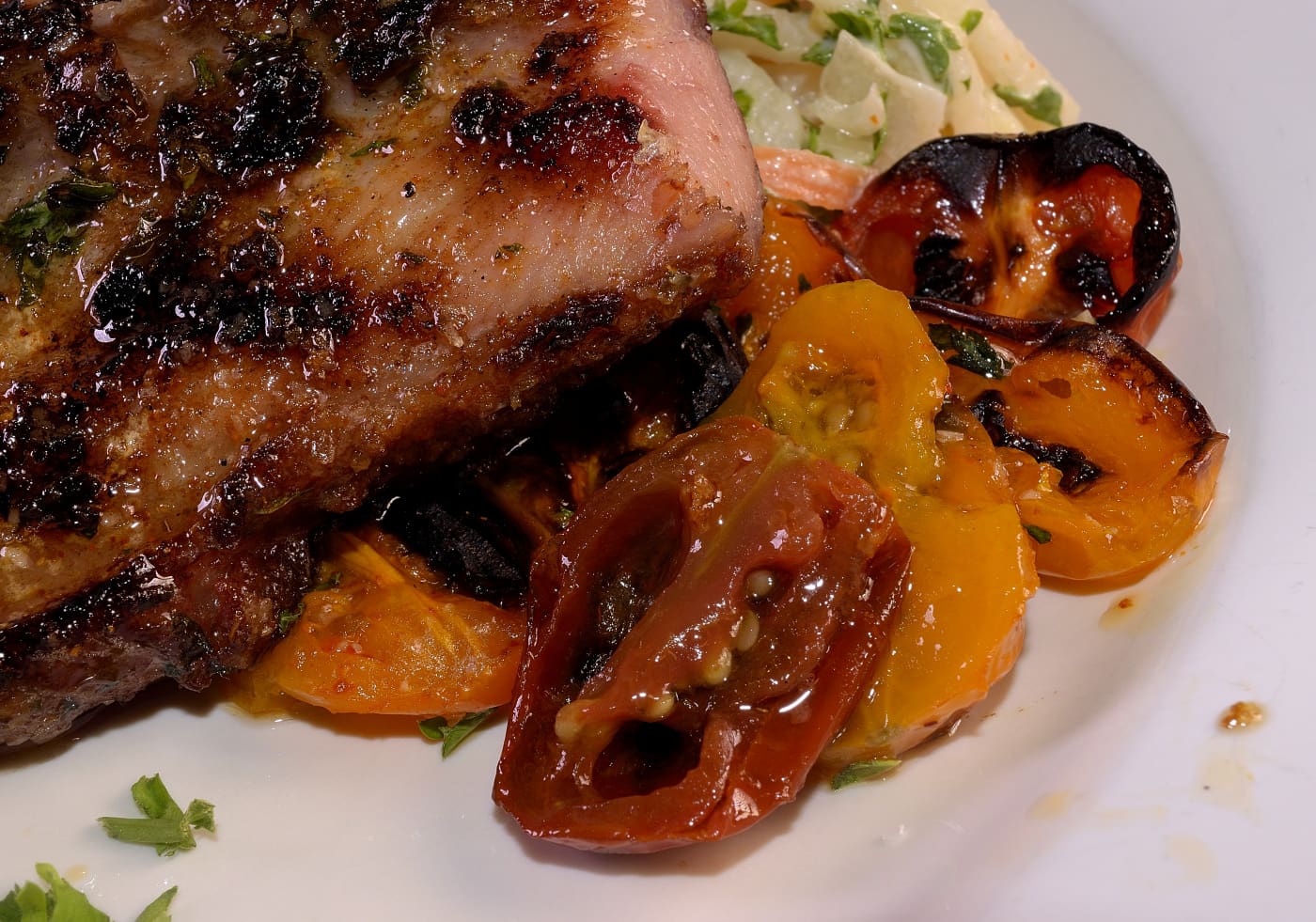
Above: Oven broiled grape tomatoes–simply cut in half, season and drizzle with extra virgin oil. Roast or broil in a hot oven or salamander for five minutes.
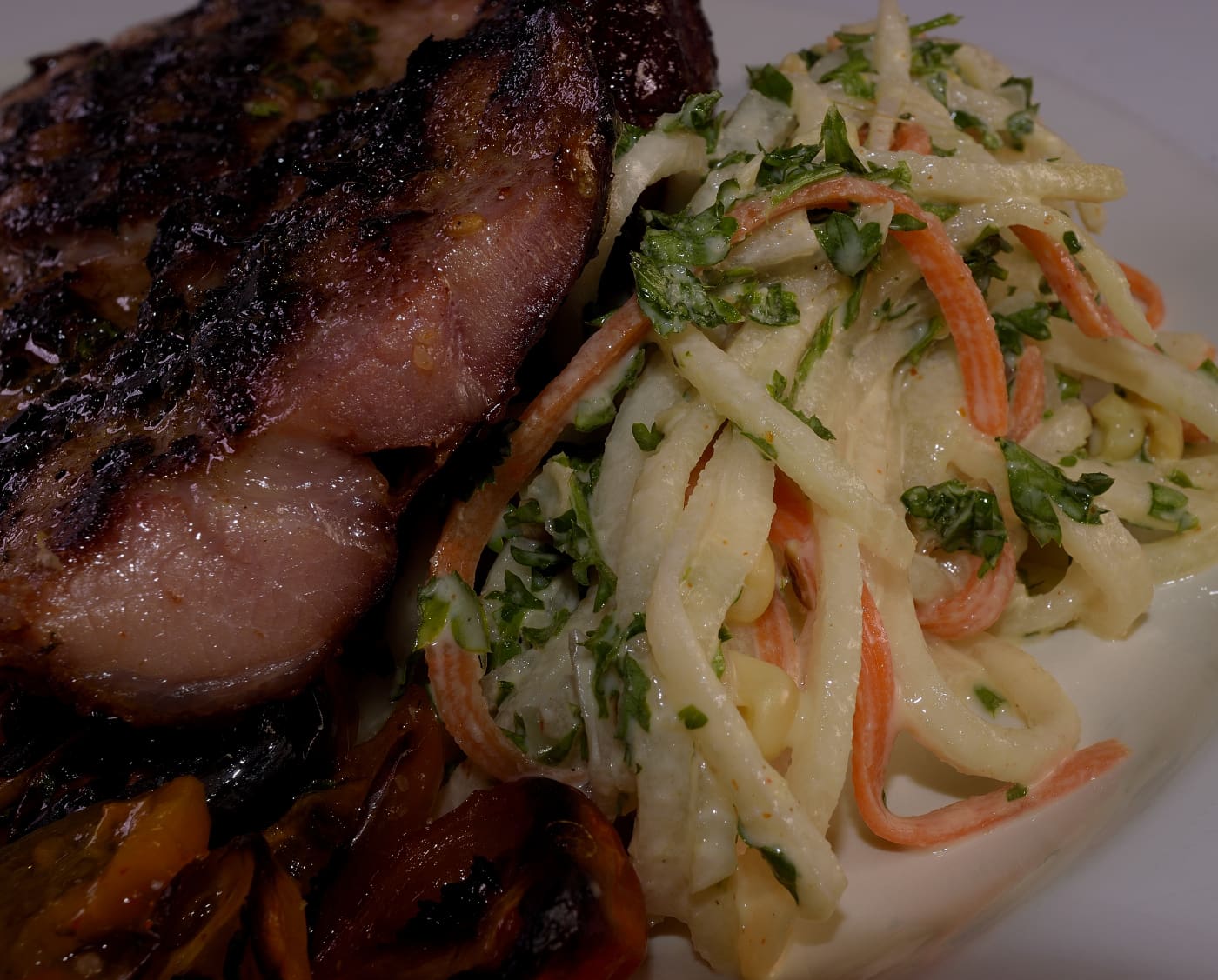
Kohlrabi slaw again!
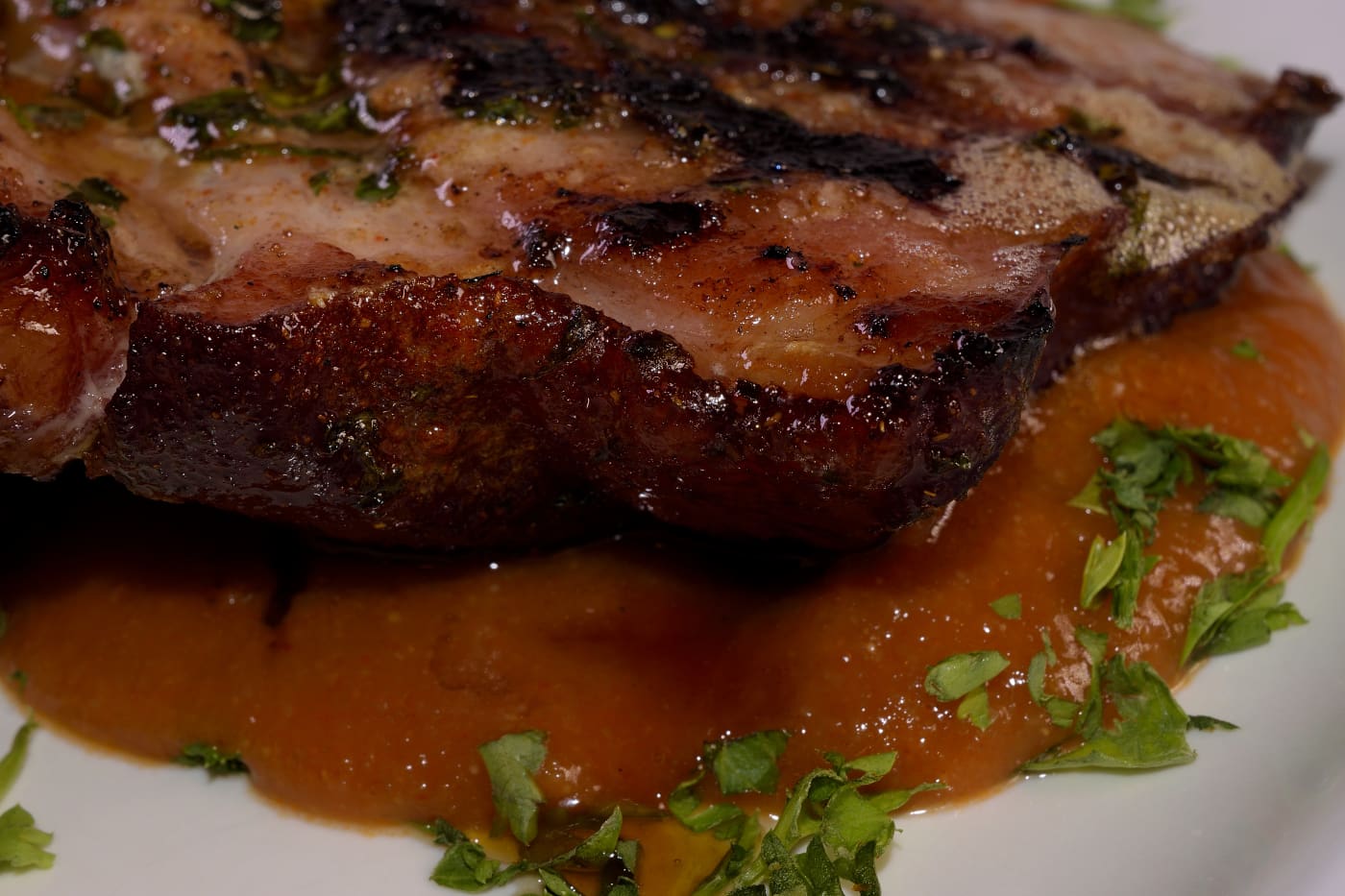
Brisk Barbecue Sauce, and, of course, chopped parsley.
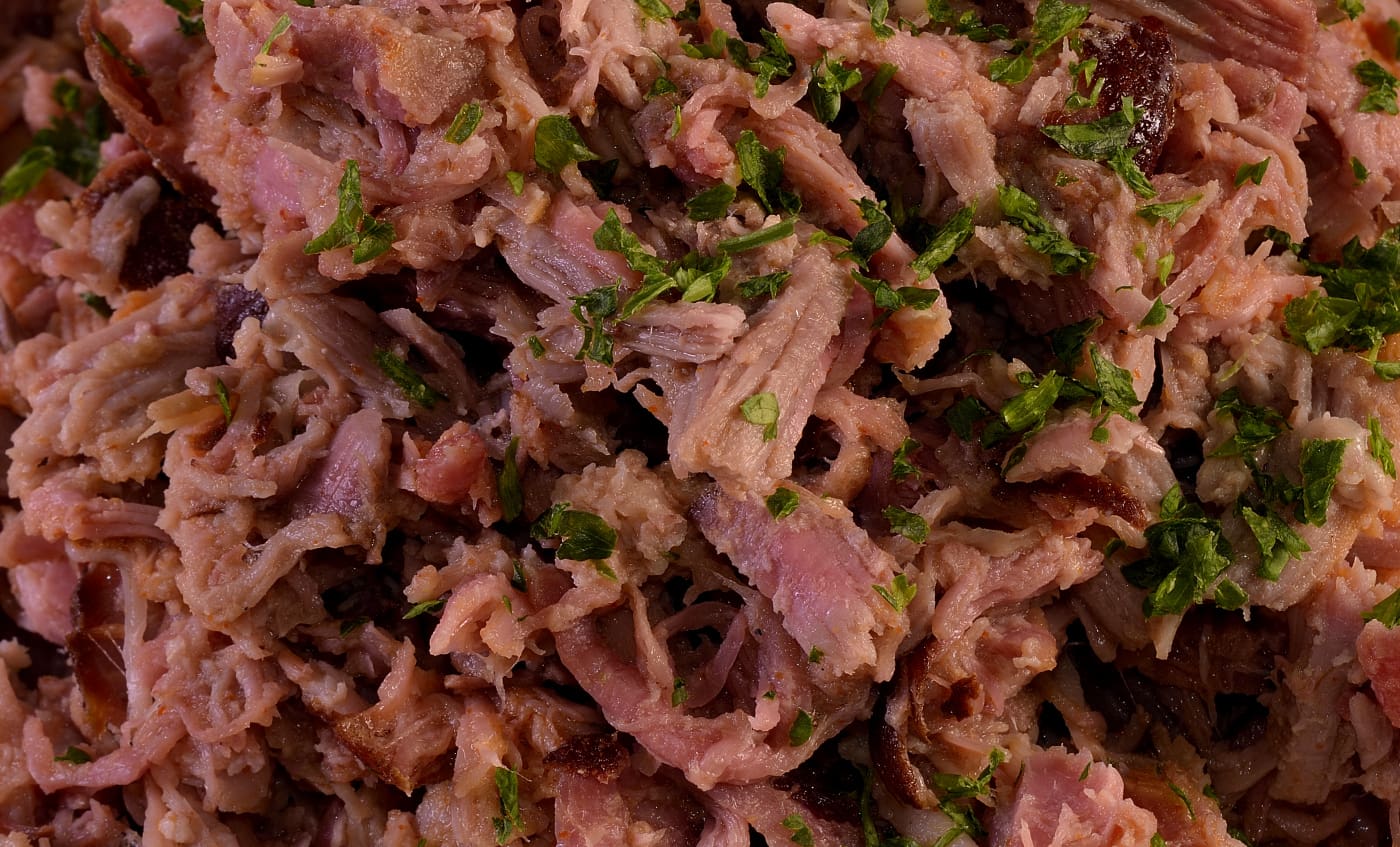
Note: If you want to proceed directly to pulled pork, visit HERE.
Norm King

